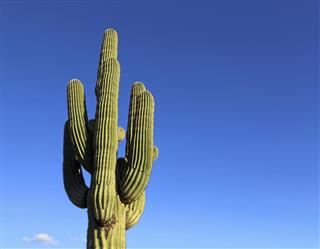
Special efforts are not required in caring for the Saguaro cactus–it is a plant that does reasonably well with little care, both indoors and outdoors. Read through the following article to understand the basics of the same.
The first thing that comes to your mind when you think of the Saguaro cactus (Carnegiea gigantea) is its attractive columnar stalk and the bluish wax film on it. It is a giant-sized cactus species which is found in the Sonoran Desert of Arizona, California and Mexico. It can grow up to a height of 40-60 feet. The lifespan of this cactus is 200 years or more; however, its growth rate is very slow. In the first 10 years, it will hardly grow to a height of 6 inches, its first pink blooms can be seen after 35 years, and sprouts appear after 70-75 years. In that way it can be kept as a house plant for years before it gets its giant structure, and can be grown both outdoors as well as indoors.
Caring Essentials and Tips
The Saguaro cactus is grown from seeds. The soil in which the cactus is grown should have a good drainage–it should consist of one part potting mix, one part sand, and one part coarse gravel. Once the soil has been prepared, place the soil in a small or medium-sized pot. Make a hole that is one-eighth inch deep, place a seed into it, and put a pinch of soil over it. Sparingly water the soil and wrap it up tightly with a plastic sheet. After the seeds are planted, you have to follow the steps given below for proper care of the plant.
Light and Temperature Requirements
The newly planted seeds of saguaro should be kept in cover for 4-6 weeks. During this time, the pot should be placed in an area where it can receive bright light, but not direct sun exposure. This cactus type needs full sun for proper growth. Saguaro grows well in hot or moderate temperatures throughout the year. In an arid climate zone, this plant can be kept outdoors all year round. However, in temperate climates, where the winter temperature reads at 45 degrees Fahrenheit, the plant should be brought indoors to avoid freeze damage.
Water Requirements
In the first 6 weeks of planting the seeds, you should water the soil lightly after a gap of 10 days. Later, in the growing season (spring to summer), water the cactus generously once in a month. There is a simple test to check whether you need to water the cactus or not. Press the skin of the cactus with your finger. If a dent is formed on its surface, then it suggests that the cactus needs some watering. However, when the skin is firm, it is an indication that you need not water the plant. In the winter months, the cactus becomes dormant and no watering is required.
Fertilizer Requirement
If grown outdoors, the plant does not require fertilizing at all. However, for those plants which are grown indoors, a low nitrogen fertilizer during the growing months is needed. You should fertilize the soil after 2-3 months. 5-10-10 fertilizer is best suited for this purpose.
Protection from Pests and Diseases
Saguaro plants tend to get attacked by harmful bacteria that can even lead to the death of the cactus. The bacterial attack can destroy the living cells of the plant. If it is neglected for long, it may even kill the plant. The visible signs of infection on the cactus are holes on its trunk. Check the plant regularly for these; if you find any, cut the part off with the help of a knife and put some sulfur on that spot. This is an effective treatment for the bacterial infection.
Patience is the most important factor that you must possess for growing this cactus. This is because it will hardly grow an inch in one year. If you do not possess that much patience for growing cactus from seeds, then you can bring small-sized saguaro cactus plants from a nursery and keep them as outdoor or indoor plants.

